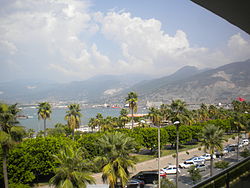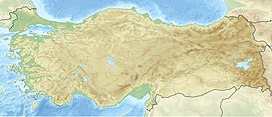Nur Mountains
| Nur Mountains | |
|---|---|
| Alma-Dağ, Amanos Mountains | |
| Highest point | |
| Elevation | Bozdağ Dağı |
| Naming | |
| Native name | Nur Dağları (Turkish) |
| Geography | |
| Country | Turkey |
| Province | Hatay |


The Nur Mountains (Turkish: Nur Dağları, "Mountains of Holy Light"), formerly known as Alma-Dağ,[1] the ancient Amanus (Ancient Greek: Ἀμανός), medieval Black Mountain, or Jabal al-Lukkam in Arabic,[2] is a mountain range in the Hatay Province of south-central Turkey. It begins south of the Taurus Mountains and the Ceyhan river, runs roughly parallel to the Gulf of İskenderun, and ends on the Mediterranean coast between the Gulf of İskenderun and the Orontes (Asi) river mouth.
Geography
[edit]The range is around 100 miles (200 kilometers) in length and reaches a maximum elevation of 2,240 m (7,350 ft). It divides the coastal region of Cilicia from Antioch and inland Syria, making a natural border between Asia Minor (Anatolia) in the southeast region and the rest of Southwest Asia. Its highest peak is Bozdağ Dağı. A major pass through the mountains known as the Belen Pass (Syrian Gates) is located near the town of Belen, and another pass known as the Amanic Gates (Bahçe Pass) lies farther north.
Monasticism in the Black Mountain
[edit]The specific term "Mount Amanus" is referred to by ancient writers.[3][4] In the Middle Ages, it was called the Black Mountain in Byzantine Greek, Armenian, Syriac and Latin. While monks had been leading a solitary life in the mountains since the fourth century,[5] it was during the 10th and 11th century that the area became a major monastic hub for Byzantine monasticism, in its importance for the Byzantine East comparable to the influence of Athos in the Byzantine West.[6] There were numerous Armenian, Melkite, Jacobite, Georgian, and Catholic monasteries and hermits in the mountains.[5] On account of this, it was called Gâvur Dağ (Mount of Infidels) by the Turks. In 1028, the Emperor Romanos III, disturbed by the number of "heretical" (i.e., Syriac and Armenian) monks in the Black Mountain, tried to draft them for his campaign against Aleppo. In the 1050s the famous physician Ibn Butlan, who later would himself become a monk in Antioch, was impressed by the general health of monasticism in the region and especially of the monastery of St Simeon the Younger.[5] In 1066, the monasteries were devastated by Afshin Bey who killed many monks.[7] In 1098, the monks gave provisions to the Crusader army besieging Antioch.[8] The monasteries were plundered again after the Battle of Ager Sanguinis in 1119 and many monks slain.[9]
See also
[edit]References
[edit]- ^ Merriam-Webster's Geographical Dictionary, Third Edition. Springfield, MA: Merriam-Webster. 1997. p. 855. ISBN 9780877795469. Retrieved 19 January 2017.
- ^ Mohsen Zakeri, Sasanid Soldiers in Early Muslim Society: The Origins of 'Ayyārān and Futuwwa (Otto Harrassowitz Verlag, 1995), p. 151.
- ^ Grote, George (1862). A History of Greece. London: John Murray. p. 312. Retrieved 19 January 2017.
Mount Amanus.
- ^ Anthon, Charles (1872). A Classical Dictionary. New York: Harper & Brothers. Retrieved 19 January 2017.
- ^ a b c Hamilton, Bernard; Jotischky, Andrew (2020). Latin and Greek Monasticism in the Crusader States. Cambridge University Press. ISBN 9780521836388.
- ^ Glynias, Joe (2020). "Byzantine Monasticism on the Black Mountain West of Antioch in the 10th-11th Centuries". Studies in Late Antiquity. 4 (4): 408–451. doi:10.1525/sla.2020.4.4.408. S2CID 234664991.
- ^ Beihammer, Alexander Daniel (2017). Byzantium and the Emergence of Muslim-Turkish Anatolia, Ca. 1040-1130 Volumen 20 de Birmingham Byzantine and Ottoman Studies. Taylor & Francis. ISBN 9781351983860.
- ^ Jos J. S. Weitenberg, "The Armenian Monasteries in the Black Mountain", in K. Ciggaar and M. Metcalf (eds.), East and West in the Medieval Eastern Mediterranean, Vol. 1 (Peeters, 2006), pp. 79–81.
- ^ WELTECKE, DOROTHEA (May 2003). "THE SYRIAC ORTHODOX IN THE PRINCIPALITY OF ANTIOCH DURING THE CRUSADER PERIOD". Antioch from the Byzantine Reconquest Until the End of the Crusader Principality: Acta of the Congress Held at Hernen Castle in May 2003: 112.

